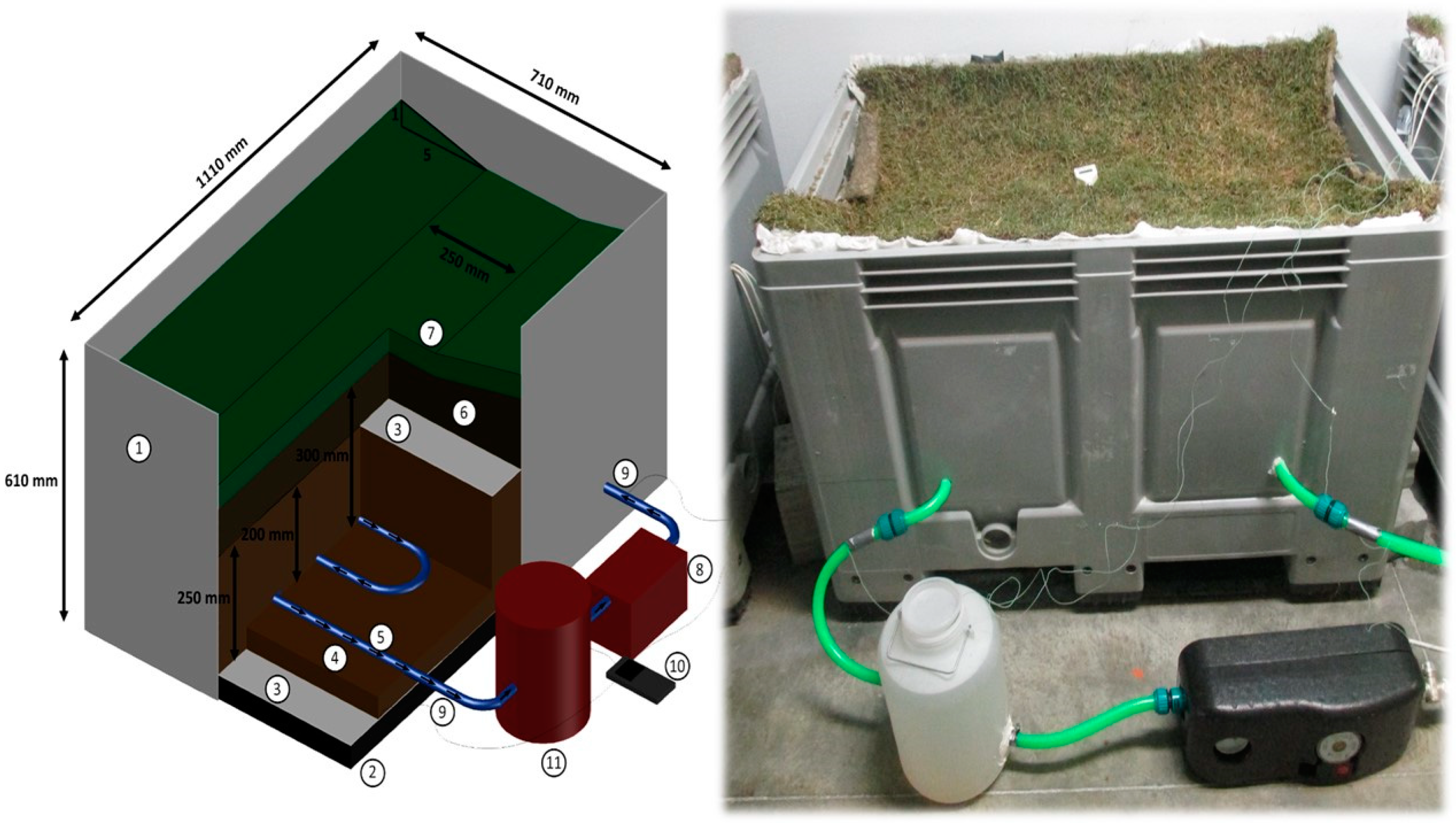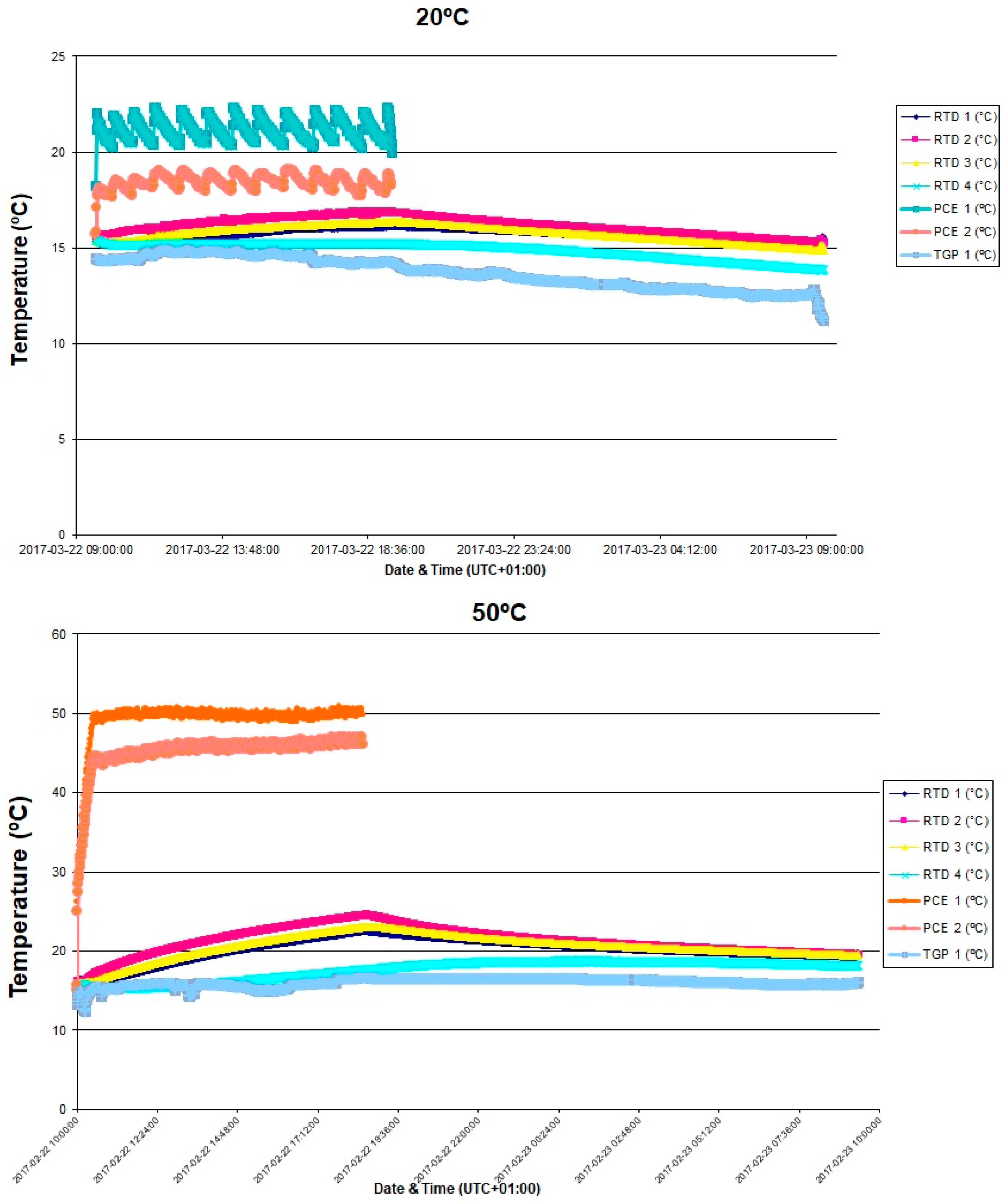Thermal Performance of Wet Swales Designed as Multifunctional Green Infrastructure Systems for Water Management and Energy Saving †
Abstract
:1. Introduction
2. Methodology
- Sub-base layer 200 mm thick (4 in Figure 1): Limestone aggregates 18 and 35 mm particle size.
- GSHP simulated looping (5 in Figure 1): polypropylene flexible pipe 20 mm diameter and 5 m length was placed 50 mm above the bottom line of the sub-base layer.
- Base layer 100 mm thick supporting grass growth in the surface layer (6 in Figure 1).
- Surface layer made out of grass (7 in Figure 1).
3. Results and Discussions
4. Conclusions and Future Research Lines
Author Contributions
Funding
Acknowledgments
Conflicts of Interest
References
- Sañudo-Fontaneda, L.A.; Anderson, A.; Hunt, W.F. Green Streets: The opportunity to design resilient stormwater management in the cities of the future. In Stormwater: Sources, Monitoring and Management; Nova Science: New York, NY, USA, 2018; accepted. [Google Scholar]
- Woods Ballard, B.; Wilson, S.; Udale-Clark, H.; Illman, S.; Ashley, R.; Kellagher, R. The SuDS Manual; CIRIA 753; CIRIA: London, UK, 2015; p. 968. [Google Scholar]
- Charlesworth, S.M.; Faraj-Lloyd, A.S.; Coupe, S.J. Renewable energy combined with sustainable drainage: Ground source heat and pervious paving. Renew. Sustain. Energy Rev. 2017, 68, 912–919. [Google Scholar] [CrossRef]
- Tota-Maharaj, K.; Scholz, M.; Coupe, S.J. Modelling temperature and energy balances within geothermal paving systems. Road Mater. Pavement Des. 2011, 12, 315–344. [Google Scholar] [CrossRef]
- del Castillo-García, G.; Borinaga-Treviño, R.; Sañudo-Fontaneda, L.A.; Pascual-Muñoz, P. Influence of pervious pavement systems on heat dissipation from a horizontal geothermal system. Eur. J. Environ. Civ. Eng. 2013, 17, 956–967. [Google Scholar] [CrossRef]
- Abrahams, J.C.; Coupe, S.J.; Sañudo-Fontaneda, L.A.; Schmutz, U. The Brookside Farm Wetland Ecosystem Treatment (WET) System: A Low-Energy Methodology for Sewage Purification, Biomass Production (Yield), Flood Resilience and Biodiversity Enhancement. Sustainability 2017, 9, 147. [Google Scholar] [CrossRef]


Publisher’s Note: MDPI stays neutral with regard to jurisdictional claims in published maps and institutional affiliations. |
© 2018 by the authors. Licensee MDPI, Basel, Switzerland. This article is an open access article distributed under the terms and conditions of the Creative Commons Attribution (CC BY) license (http://creativecommons.org/licenses/by/4.0/).
Share and Cite
Andrés-Valeri, V.C.; Sañudo-Fontaneda, L.A.; Rey-Mahía, C.; Coupe, S.J.; Alvarez-Rabanal, F.P. Thermal Performance of Wet Swales Designed as Multifunctional Green Infrastructure Systems for Water Management and Energy Saving. Proceedings 2018, 2, 1433. https://doi.org/10.3390/proceedings2231433
Andrés-Valeri VC, Sañudo-Fontaneda LA, Rey-Mahía C, Coupe SJ, Alvarez-Rabanal FP. Thermal Performance of Wet Swales Designed as Multifunctional Green Infrastructure Systems for Water Management and Energy Saving. Proceedings. 2018; 2(23):1433. https://doi.org/10.3390/proceedings2231433
Chicago/Turabian StyleAndrés-Valeri, Valerio C., Luis A. Sañudo-Fontaneda, Carlos Rey-Mahía, Stephen J. Coupe, and Felipe P. Alvarez-Rabanal. 2018. "Thermal Performance of Wet Swales Designed as Multifunctional Green Infrastructure Systems for Water Management and Energy Saving" Proceedings 2, no. 23: 1433. https://doi.org/10.3390/proceedings2231433
APA StyleAndrés-Valeri, V. C., Sañudo-Fontaneda, L. A., Rey-Mahía, C., Coupe, S. J., & Alvarez-Rabanal, F. P. (2018). Thermal Performance of Wet Swales Designed as Multifunctional Green Infrastructure Systems for Water Management and Energy Saving. Proceedings, 2(23), 1433. https://doi.org/10.3390/proceedings2231433






